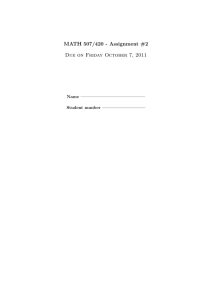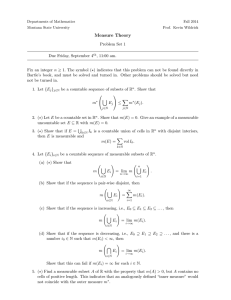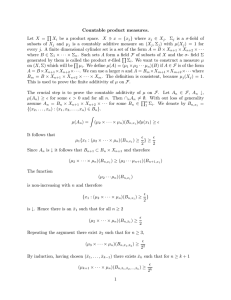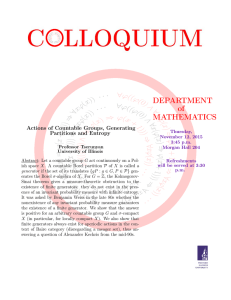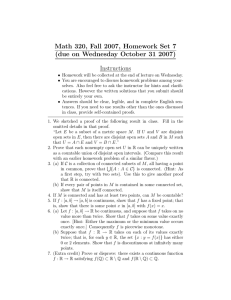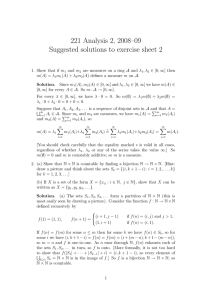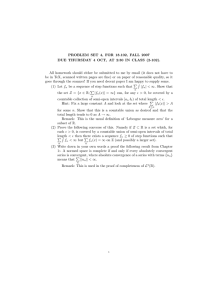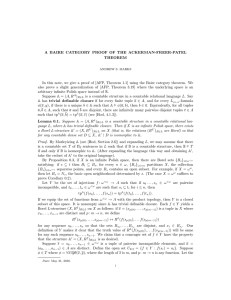1 -fields �
advertisement
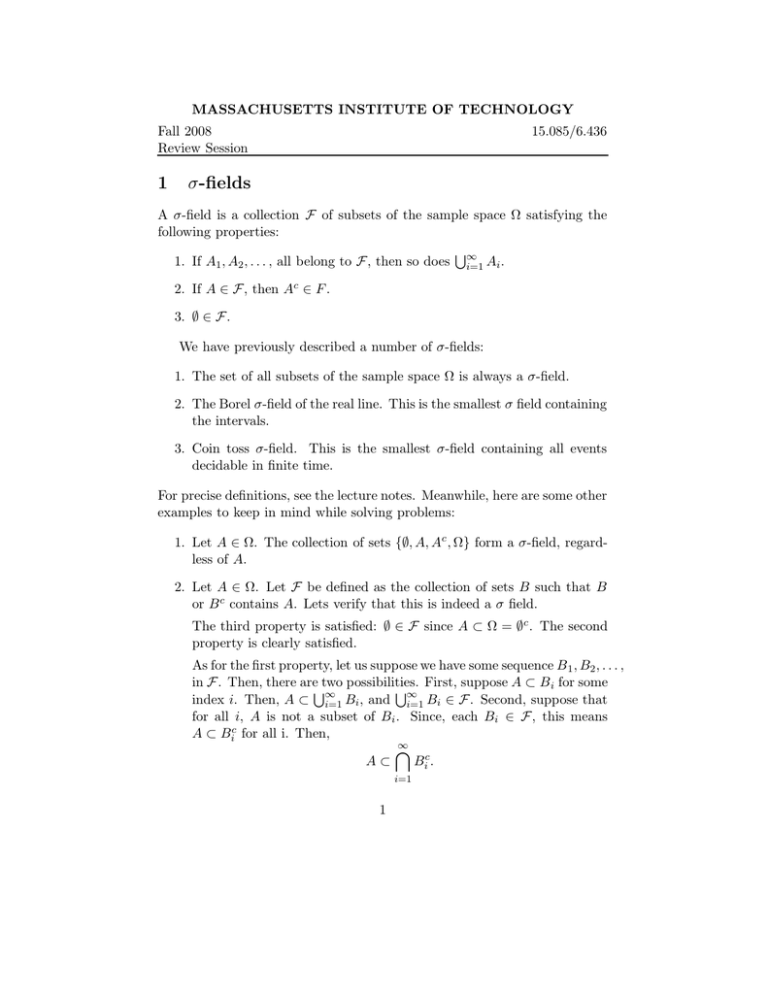
MASSACHUSETTS INSTITUTE OF TECHNOLOGY
Fall 2008
Review Session
1
15.085/6.436
�-fields
A �-field is a collection F of subsets of the sample space � satisfying the
following properties:
�
1. If A1 , A2 , . . . , all belong to F, then so does �
i=1 Ai .
2. If A � F, then Ac � F .
3. � � F.
We have previously described a number of �-fields:
1. The set of all subsets of the sample space � is always a �-field.
2. The Borel �-field of the real line. This is the smallest � field containing
the intervals.
3. Coin toss �-field. This is the smallest �-field containing all events
decidable in finite time.
For precise definitions, see the lecture notes. Meanwhile, here are some other
examples to keep in mind while solving problems:
1. Let A � �. The collection of sets {�, A, A c , �} form a �-field, regard­
less of A.
2. Let A � �. Let F be defined as the collection of sets B such that B
or B c contains A. Lets verify that this is indeed a � field.
The third property is satisfied: � � F since A � � = � c . The second
property is clearly satisfied.
As for the first property, let us suppose we have some sequence B 1 , B2 , . . . ,
in F. Then, there are�two possibilities.
�� First, suppose A � B i for some
�
index i. Then, A � i=1 Bi , and i=1 Bi � F. Second, suppose that
for all i, A is not a subset of Bi . Since, each Bi � F, this means
A � Bic for all i. Then,
�
�
A�
Bic .
i=1
1
But since
�
�
�
(
Bi )c =
Bic ,
i=1
i=1
we get that
A�(
and therefore
�
�
i=1 Bi
�
Bi )c ,
i=1
� F.
3. All subsets B of the real line such that B or B c is countable1 .
The proof of this parallels the last example. If B 1 , B2 , . . . are all in F,
then either all are countable, or at least one is uncountable. If all are
countable, then their union is countable. If at least one is uncountable,
then its complement must be countable. Thus the intersections of B ic
are countable, which shows that the union of B i is in F.
Two common mistakes relating to �-fields are:
1. If A � F and B � A, then B � F.
This is incorrect. Take, for example, the example from above: F is
the collection of sets B such that B or B c contains A, with A = {1, 2}.
Then, {1, 2, 3} � F, but {1} �
/ F.
Generally, this would imply every set is in F, since � � F necessarily,
and every set is a subset of �.
2. The union of an uncountable collection of sets in F is in F.
This is not correct. Take any subset of the real line X. Then,
X=
{x}.
x�X
Now we know that each singleton {x} is Borel measurable, but this
does not imply that every subset X of the real line is Borel measurable.
Lets work out some simple exercises.
1. Suppose B � F. Let F � be defined as
�
F � = {A B | A � F}.
1
Here “countable” includes finite sets.
2
Show that F � is a �-field of subsets of B.
Solution: clearly, � � F � .
�
� , then C = A
B for some
A � F. Then,
Ac � F, so that
If C � F �
�
�
C � = Ac B � F � . However, C C � = B and C C � = �, so that
C � = C c . This shows that complements belong to F � .
Finally, if C1 , C2 , . . . , � F � , there must exist sets Ai such that
�
Ci = Ai B.
Then,
��
i=1 Ai
� F, so that (
(
�
i=1
Ai )
�
��
i=1 Ai )
B=
�
i=1
(Ai
�
B � F � . However,
�
B) =
�
Ci ,
i=1
showing that F is closed under countable unions.
2. Suppose instead that requiring that F is closed under countable unions,
we require that F is closed under countable disjoint unions. Will the
result be the same?
The answer is no. Let � = {1, 2, 3, 4} and let F be the empty-set, the
whole space, and the collection of all two-element subets of �:
F = {�, �, {1, 2}, {1, 3}, {1, 4}, {2, 3}, {2, 4}, {3, 4}}.
Then, F is closed under disjoint unions, but not unions.
2
Probability
1. Can a discrete probability space contain an infinite number of inde­
pendent events A1 , A2 , . . . , each with probability 1/2?
The answer is no. Each
probability
space would lie in one
� point�of the
�
�
c
c
c
of the four sets A1 A2 , A1 A2 , A1 A2 , A1 A2c , and hence have
probability at most (1/2)2 . We can do this for arbitrarily n, to get
that each point has probability 0.
2. Suppose the sequence An of measurable sets is nearly disjoint in the
sense that
�
P (An Am ) = 0,
3
for n =
∅ m. If A =
�
�
i=1
An , show that
�
�
P (A) =
P (Ai ).
i=1
Solution: define
Bi = A i
Then:
�
�
�
�
Ac1 Ac2 · · ·
Aci−1 .
�
�
Ai =
Bi
i=1
i=1
and P (Bi ) = P (Ai ), and Bi are disjoint.
3. Suppose � = {1, 2, 3, 4, 5}, and F is the set of all subsets of �. Let
P (A) = |A|/5 for all A. Show that if A, B are independent, then one
of them must be the empty set or �.
Solution: We have
P (A, B)
P (A) P (B)
=
,
5
5
5
or
�
5|A
B| = |A||B|
So |A||B| must be divisible by 5. Since 5 is a prime, it follows that
one of the cardinalities is 5 or 0.
4
MIT OpenCourseWare
http://ocw.mit.edu
6.436J / 15.085J Fundamentals of Probability
Fall 2008
For information about citing these materials or our Terms of Use, visit: http://ocw.mit.edu/terms.
